Newsletter
The Hashtagification of Chinese Propaganda
From tech-powered messaging to pop culture politics, China’s propaganda has undergone a major transformation in the social media age.
Published
4 months agoon

PREMIUM NEWSLETTER | ISSUE #38
Dear Reader,
October 1st marked the 75th anniversary of the founding of the People’s Republic of China. Flags, hearts, balloons—National Day celebrations turned Chinese social media red.
Among the key players in leading the propaganda around National Day was People’s Daily, the official newspaper of the Communist Party of China. To commemorate the occasion, People’s Daily published a column titled “Today’s China, Tomorrow’s China” (今天的中国,明天的中国)1, outlining a clear vision for the future and emphasizing China’s rise under the Party’s leadership.
The article highlighted how hard work and perseverance are crucial to achieving the ‘China Dream,’ with national unity being the driving force behind the country’s continued progress. It also stressed the pivotal role of China’s youth in shaping the future of the nation.
The article was accompanied by four posters, each conveying a specific message:
“Today’s China is a China where dreams are continuously realized” (今天的中国是梦想接连实现的中国)
“Today’s China is a China full of vibrancy and vitality” (今天的中国是充满生机活力的中国)
“Today’s China is a China that carries on the national spirit” (今天的中国是赓续民族精神的中国)
“Today’s China is a China closely connected to the world” (今天的中国是紧密联系世界的中国)

A related hashtag, “75th Anniversary of the Founding of the People’s Republic of China” (#新中国成立75周年#), received over 590 million views on Weibo.
But People’s Daily also put out a much simpler message, posting the hashtag: “I Love You, China” (#我爱你中国#).
This hashtag was accompanied by an online poster featuring the Chinese characters for “China.” The characters in the picture are shaped by various symbols representing both traditional and modern China, from lanterns and Tiananmen to rockets and railways. That post was shared over six million times.

The immense popularity of the poster and the “I Love You China” hashtag page, initiated by People’s Daily and garnering over eight billion views through the times, highlights the strength of Party-led propaganda in the social media era.
A Major Shift
A few days ago, De Balie, a cultural venue in Amsterdam, hosted an event focused on how Chinese state propaganda has evolved, coinciding with the 75th anniversary of the People’s Republic of China. As a participant in the discussion, I’ve recently been reflecting on the nature of Chinese propaganda in the digital age.
Propaganda has always been a key element of the Party’s strategy—not just for the past 75 years, but for over a century. Since the founding of the Central Propaganda Department in 1924, three years after the establishment of the Communist Party, propaganda has played a central role in shaping official narratives. China’s propaganda system exerts significant influence over nearly every major medium involved in disseminating information within the country, from news outlets and educational institutions to cultural organizations, artistic circles, and literary institutions.2
China’s rapid digitalization and the rise of social media posed significant challenges for officials in disseminating propaganda, particularly in the early 2010s when there was an explosion of self-media, app culture, and intense celebrity idolization. Amid this cacophony of new media channels, Party propaganda was increasingly overlooked as people’s attention shifted to what they found more engaging, such as movie stars and other celebrities representing new, exciting lifestyles.3
This was not the first ‘disruptive force’ the Party Propaganda Department had to confront. (Side note: Chinese officials, aware of the negative connotations of ‘propaganda’ in English—though it’s a neutral term in Chinese, 宣传—later changed its English name to the ‘Publicity Department.’)
As Stefan Landsberger notes in Chinese Propaganda Posters,4 the Party’s well-established system for propaganda and political education faced similar challenges in the 1980s following the Open Door policy. This policy significantly transformed Chinese society, bringing a wave of foreign cultural and lifestyle influences and accelerating the spread of electronic media.
Although the spread of non-official media and information may have disrupted the central messaging dynamics of the Propaganda Department in the 1980s, the growing presence of radio and television sets in people’s homes also allowed Party leaders to shift their focus from propaganda posters to new media as a means of communicating political messages.5
A similar shift has occurred over the past seven to eight years when it comes to social media. Initially, propaganda authorities struggled to convey official messages on Weibo and other emerging digital platforms, but in 2017, China’s propaganda system saw a pivotal change in its approach to domestic social media, particularly on Weibo.
Instead of trying to pull young people into traditional Party narratives, it began weaving propaganda directly the fabric of social media itself —blending politics seamlessly into the digital content young audiences were already engaging with.
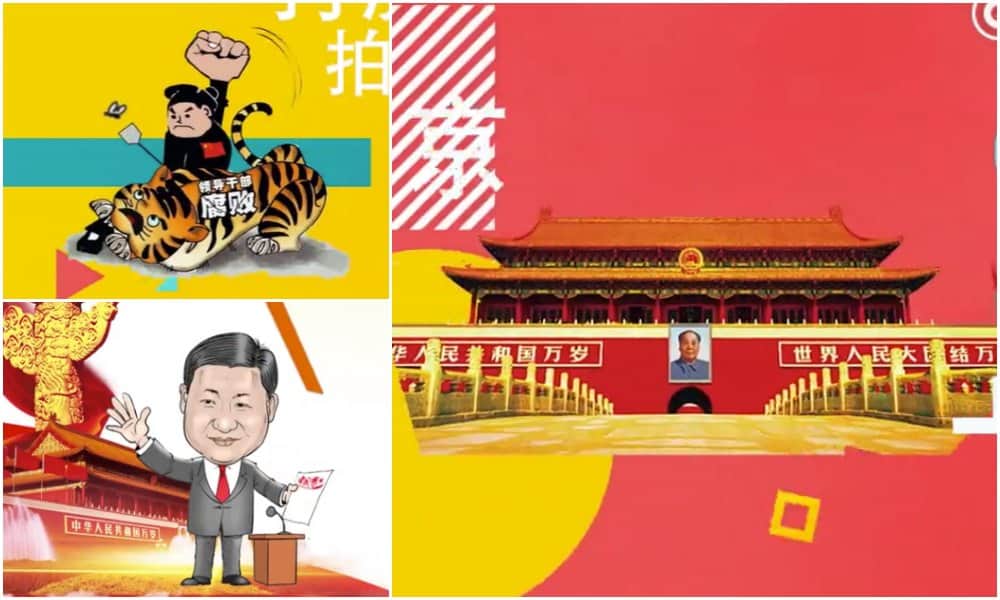
No three-and-a-half-hour speech, but a three-and-a-half minute video. In 2017, Chinese state media explained China’s new strategies through catchy rap music and trendy graphics. Read more.
2017 was a pivotal year for Chinese propaganda with three major events: the One Belt One Road (OBOR) Summit, the 19th Party Congress, and the APEC Summit. For each occasion, publicity authorities launched distinctive, high-profile campaigns.
The OBOR Summit featured several high-production videos with catchy tunes, often starring foreigners (though some found them awkward). The 19th Party Congress saw a flood of new propaganda videos and initiatives, including a clapping game produced by Tencent that allowed users to applaud Xi Jinping’s speech. Meanwhile, the APEC Summit videos saw a manga-style version of Xi Jinping, portraying him as lovable and approachable.
Hashtagification of Propaganda
Propaganda departments in China have adapted various strategies over the past few years to make official Party narratives more appealing by adjusting to the fast-paced, fleeting, and trendy nature of China’s social media environment. I’d call this the ‘hashtagification’ of Chinese propaganda—turning political messaging into viral trends by embedding it in hashtags and social media content. These are essentially hashtag-driven narratives that netizens can easily engage with and share.
Within this movement, I see six major strategies of digital propaganda emerging on Weibo and other social apps, such as Douyin, from 2017 to 2024.
📌 1. Old Message, New Media: Revival of Classic Propaganda
The types of posts that People’s Daily shares around National Day and other celebrations often echo classic nationalist messages about unity and national pride. This is part of a broader strategy within China’s social media propaganda, focusing on strong, simple messages that, at their core, are not much different from the political narratives promoted in previous decades. However, these messages are now disseminated through modern channels, using more sophisticated techniques and production methods. These can include online posters, as well as music or high-quality videos (example).
📌 2. Double Agenda: Foreign-Facing Propaganda with Domestic Goal
Although there’s traditionally been a clear distinction between domestic propaganda and waixuan (“external propaganda”), the past few years have seen the rise of a new kind of propaganda. It appears to target an international audience but is actually aimed at bolstering domestic support and reinforcing a positive image of China. Assertive or aggressive videos and posts, supposedly directed at foreign viewers, are often used to stir national pride at home. A good example of this is the Xinhua video series featuring Young Lady Guoshe (国社小姐姐), whose real name is Wang Dier (王迪迩), an anchor for Xinhua who previously worked for CCTV. If you’re unsure what this looks like, check the full clip here.
📌 3. Grassroots ‘Propaganda’ in Official Communication
Over the past few years, particularly during the Covid period, official channels began repurposing satirical online artworks created by independent artists or popular nationalistic influencers as a form of national propaganda. Much of this art was produced by Chinese cartoonists and artists, mocking Western hypocrisy and political leaders. These pieces were then retweeted and widely shared by official Chinese channels, amplifying domestic support and fueling anti-Western sentiment. You can read more about this trend here.

‘Investigate Thoroughly! Except Here’ (‘彻查!除了这儿’) satirical illustration by artist 半桶老阿汤 / Half Can of Old Soup in response to US calls for investigation into the origins of Covid in China while ignoring a possible link with Fort Detrick. This post was shared by the Communist Youth League on social media.
📌 4. Tech-Driven Party Messages
The use of advanced technologies such as artificial intelligence, virtual reality, and gamification by Chinese state media serves a dual purpose: reinforcing the Party’s messaging while simultaneously showcasing China’s digital innovation. By integrating technology with propaganda, the Party’s message becomes more engaging and interactive, while also projecting China as a leading tech power. For instance, in recent years, the annual CCTV New Year’s Gala has become a platform to display China’s cutting-edge digital technologies on stage. Online, tech and propaganda are frequently intertwined, such as in the aforementioned clapping game by Tencent. Other examples include virtual newsreaders for state media and the ‘Study Xi app’ (Xuexi Qiangguo), which allows users to earn points for engaging with official Party content. You can read more about these innovations here and here.
📌 5. Pop Culture Propaganda
By ‘Pop Culture Propaganda,’ I refer to the blending of propaganda with pop culture in various ways. One example is the use of Chinese celebrities to promote official Party messages, such as the 2017 campaign for China’s New Era (hashtag: ‘Give A Shout-Out to the New Era‘) or the Social Credit song launched by the Communist Youth League. Another form of this propaganda involves colorful and cute animations and cartoons that primarily appeal to younger generations. These often incorporate Japanese influences, like anime and manga, which are especially popular among Chinese youth, making propaganda more accessible and attractive. Currently, many manga-themed propaganda-style images are circulating, blurring the lines between fan-made content and official productions (as mentioned in point 3!).

Official or not? Official channels sometimes share non-official digital art on their pages, while everyday netizens often post official “pop propaganda” on their own accounts (Images via Weibo).
📌 6. Guerrilla Propaganda: Coordinated, Multi-Front Engagement Across Media & Influencers
A final technique I’ve observed on Chinese social media since 2016-2017 is topic-centered propaganda that is spread simultaneously across multiple platforms. In these campaigns, social media, local authorities, businesses, and influencers collaborate to create a coordinated wave of messaging. A notable example is the 2021 Xinjiang cotton campaign, which followed H&M and the Better Cotton Initiative’s boycott of Xinjiang cotton over alleged human rights abuses. In response, a massive pro-Xinjiang cotton campaign erupted on Weibo, with state media, Baidu, e-commerce platforms, and celebrities uniting to cancel H&M and support Xinjiang-sourced cotton. The campaign was highly effective, with the hashtag “Wo Zhichi Xinjiang Mianhua” (“I Support Xinjiang Cotton” #我支持新疆棉花#) receiving over 8 billion views on Weibo—comparable to the “I Love China” hashtag.
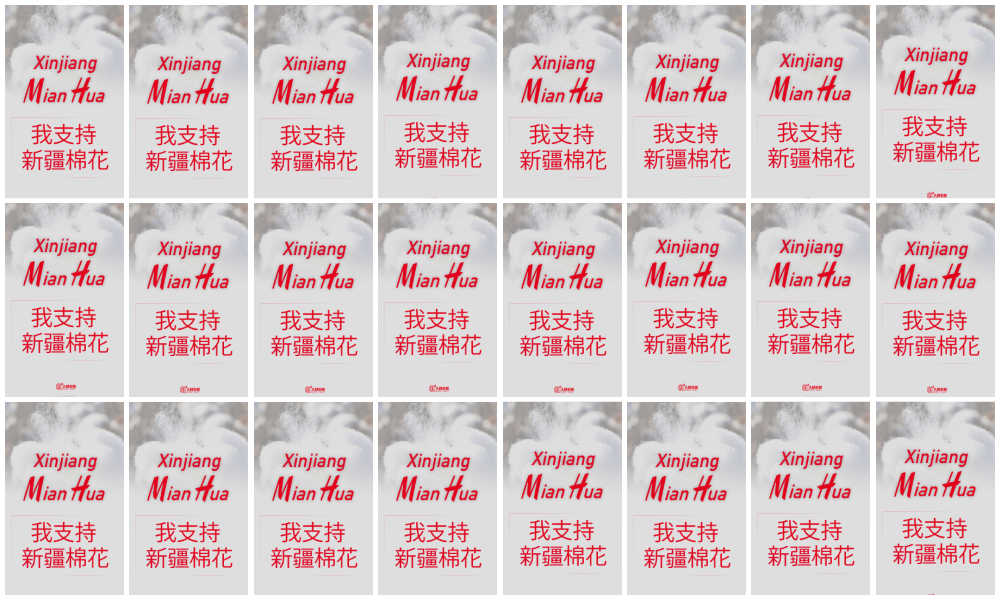
Propaganda posters by People’s Daily at the time of the Xinjiang cotton controversy. The posters say “Xinjiang Mianhua” (Xinjiang cotton) in a similar font to the H&M logo, the “H” and “M” within ‘mianhua‘ being identical to the H&M letters.
What’s particularly interesting about propaganda in China’s social media era is that, unlike previous periods, it’s no longer a one-way street from billboard to pedestrian or from TV screen to viewer. Social media is inherently interactive, and despite the overwhelming presence of official accounts on platforms like Weibo, WeChat, and Douyin, there are still over a billion individual social media users in China who can choose to scroll away, mute, or ignore these messages.
While the line between state media and other accounts is increasingly blurred, state propaganda continues to compete for attention in a dynamic and vibrant online culture.
Stefan Landsberger – In Memoriam
There is so much more to say about all of this, and it only highlights how multi-faceted and complex the topic of propaganda in China truly is.
No one understood this better than sinologist Prof. Dr. Stefan Landsberger. I was shocked and deeply saddened to hear of his sudden passing this week. Coincidentally, I received the news while working on this newsletter, with his beautiful Chinese Propaganda Posters book open on my lap.
If you’re not familiar with his name, you might have come across his work if you’ve ever read anything about Chinese propaganda. Landsberger was a leading authority on the subject, having spent decades—since the late 1970s—collecting an extensive array of posters and conducting thorough research in the field. His collection grew to become one of the largest private collections of Chinese propaganda posters in the world.

Landsberger was an Associate Professor of Contemporary Chinese History and Society at Leiden University. In that role, he also taught me Chinese Modern History when I was an undergraduate there. He was a dedicated teacher—often critical, which made him intimidating to some students—but deeply appreciated by most for his brutal honesty and his immense passion for Chinese history and modern Sinology.
One memory from 2018 stands out. I was in China as a post-graduate student and took a taxi on a cold and rainy January night in Beijing. During the ride, I struck up a conversation with the driver, who asked me where I was from. When I told him I was Dutch, he proudly shared that he had a Dutch friend—one of his dearest, he said, whom he’d known since the early 1980s. That intrigued me, as I’d never heard anything like that from a Beijing taxi driver before. As we continued talking, he mentioned that his friend was a teacher and then showed me a photo on his phone of them together. I was surprised to see that the man in the picture, smiling warmly beside the taxi driver, was none other than my own teacher Stefan Landsberger.
In a city of 21 million people, I had somehow hailed a cab driven by one of Landsberger’s oldest friends in the city, whom he had known since he was a student in Beijing. I shared this story with Dr. Landsberger later through WeChat—it made him laugh. This chance encounter left a lasting impression on me, not just because of the coincidence, but because it spoke volumes about Landsberger’s enduring love for China and his ability to cultivate deep, lasting friendships. It showed his loyalty, not just to his work and research but to the people and connections he built over decades.
Landsberger will be greatly missed. His contributions to the growing body of work on Chinese propaganda are invaluable. This ever-evolving phenomenon can only be fully understood by examining both its current trends and its historical roots—and Landsberger’s work will forever be foundational in that effort, helping to better understand “Today’s China, Tomorrow’s China.”
My thoughts are with his family and friends during this difficult time.
Best,
Manya Koetse
(@manyapan)
1 Ren Ping, “今天的中国,明天的中国” [Today’s China, Tomorrow’s China], People’s Daily, September 29, 2024, https://weibo.com/ttarticle/p/show?id=2309405083853533610297
2 David Shambaugh, “China’s Propaganda System: Institutions, Processes and Efficacy,” The China Journal 57 (2007):27-28.
3 See Willy Lam quoted in Yi-Ling Liu, “Chinese Propaganda Faces Stiff Competition from Celebrities,” AP News, October 23, 2017, https://apnews.com/article/1616c60ab01d43caae024d34cb98d532 (accessed October 12, 2024).
4 Stefan Landsberger, Chinese Propaganda Posters: From Revolution to Modernization (Amsterdam: The Pepin Press, 2001): 11.
5 Landsberger, Chinese Propaganda Posters, 15.
PS: If you’re a loyal reader of Weibo Watch, you might have noticed I’ve been trying out some changes in the newsletters lately to deliver more frequent updates while balancing things on the site. Don’t worry if this edition is missing the hot topics section—it’s not going anywhere! But if there’s anything you’d love to see in the newsletters moving forward, please let me know. Your feedback really helps with planning future editions.
What’s New

Golden Week | China celebrated its National Day Holiday earlier this month. This week-long holiday, also known as the Golden Week, is a popular time for trips, travel, and sightseeing. On Chinese social media, it has become somewhat of a tradition to post about just how busy it is in China’s various sightseeing spots. This is often done by using hashtags including “人人人人[place]人人人人.”

Being Watched | Could it be that someone is watching you while you think you’re all alone in your private hotel room? Without realizing it, some guesthouses or hotels may have hidden cameras secretly recording their guests. This issue has long been a source of concern in China and has recently become a hot topic again. The Chinese Douyin and Weibo blogger @ShadowsDontLie (@影子不会说谎), an ‘anti-fraud’ influencer, has made it his mission to expose hidden cameras in guesthouses. The controversy following his recent discoveries are perhaps just a tip of the iceberg – we’ll follow up on this story soon. Meanwhile, check out the full story here.

For the Clicks |The debate over influencers performing dangerous stunts for clout is ongoing in the West, but it has also recently gained attention in China after another motorcycle influencer was killed in a crash.

China’s Image | On October 10, 2024, De Balie hosted an event discussing how China portrays itself to its citizens and the world, marking the 75th anniversary of the People’s Republic. The panel explored the evolution of Chinese state propaganda, the public’s response, and how the emergence of digital China has reshaped the landscape. Speakers included Ardi Bouwers, Florian Schneider, Qian Huang, and myself (Qian and I appear in the second half). You can watch the full event here.
What’s Memorable

Old one-child policy propaganda slogans, especially in rural areas, remain visible on walls across China, even though they contradict the government’s current push for families to have more children due to declining birth rates. While efforts to remove these outdated slogans have intensified, some people question the urgency.
Weibo Word of the Week

Rushing to the Counties
Our Weibo word of the week is 奔县 (bèn xiàn), which translates to “rushing to the county.” This term has recently surged in Chinese media after this month’s National Day holiday, a popular travel time, saw an increased popularity of lesser-known county-level towns instead of large cities or famous tourist destinations.
According to the latest travel industry reports following the week-long holiday, bookings have significantly increased compared to last year, despite last year already being notably crowded. This year, 765 million trips were taken nationwide, marking a 10.2% increase compared to pre-pandemic 2019.
Last year, ‘domestic travel’ was the key trend, with the so-called “special forces travel” (特种兵旅游 tè zhǒng bīng lǚxíng) becoming popular among Chinese youth. That trend was all about visiting as many places as possible at the lowest cost within a limited time, often involving incredibly tight schedules and 12-hour travel days.
This year, the focus has shifted to a more relaxed and cost-effective approach. This has turned county-level tourism (奔县游 bènxiànyóu) into a new trend. People are not just visiting county-level towns to see family; more young travelers from China’s major cities are exploring nearby smaller towns for “micro-holidays” (微度假 wēi dùjià).
County-level towns in China are smaller than bigger cities like Beijing or Shanghai, but still big enough to usually have plenty to do as they are important hubs for the surrounding rural areas. In these county-level destinations, the cost of hotels and meals tends to be much cheaper than in popular tourist hotspots. Staying closer to home also reduces travel time and expenses, while offering the opportunity to visit lesser-known locations and avoid the peak tourist crowds.
According to The Observer, places like Jiuzhaigou, Anji, Shangri-La, Pingtan, Dujiangyan, and Jinghong saw booking increases of 109%, 86%, 74%, 67%, 51%, and 50%, respectively.
This is an on-site version of the Weibo Watch newsletter by What’s on Weibo. Missed last week’s newsletter? Find it here. If you are already subscribed to What’s on Weibo but are not yet receiving this newsletter in your inbox, please contact us directly to let us know.
Manya is the founder and editor-in-chief of What's on Weibo, offering independent analysis of social trends, online media, and digital culture in China for over a decade. Subscribe to gain access to content, including the Weibo Watch newsletter, which provides deeper insights into the China trends that matter. More about Manya at manyakoetse.com or follow on X.
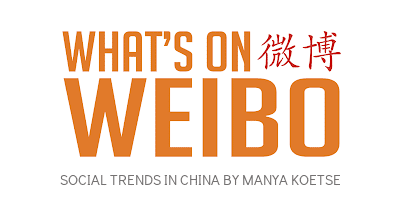
You may like

PREMIUM NEWSLETTER | ISSUE #46
Dear Reader,
Just a shorter newsletter this time (which I’ll explain), but I couldn’t overlook the death of Barbie Hsu (徐熙媛), which has sent shockwaves across Chinese social media. Her unexpected passing, along with the circumstances surrounding it, has quickly become the most talked-about topic of the week.
For those less familiar with Barbie Hsu (1976), she is generally known as “Big S” (大S) in China. The Taiwanese actress, singer, and TV host is one of those people who just always seemed to be around. She wasn’t just frequently a trending topic on Chinese social media but was also a household name, together with her sister, in the world of China’s pop culture and entertainment.
Most people will know Hsu because of the famous 2001 Taiwanese series Meteor Garden (流星花园), in which she played the award-winning role of female protagonist Shan Cai (杉菜). That role also made her famous outside of China, as the series became popular in South Korea, Singapore, the Philippines, Malaysia, and beyond.

But her career had taken off years before that success. Together with her sister Dee Hsu (徐熙娣, “Little S” 小S), she formed the pop duo SOS (later “ASOS”) in the 1990s. The name stood for Sisters Of Shu (alternative spelling of Hsu), and was the source of their “Big S” and “Little S” nicknames.
She later made a switch to movies and was a TV host and a singer. While her sister Dee Shu gained recognition as the humorous host of the long-running talk show Kangxi Coming (康熙來了), Barbie Hsu also served as a stand-in host or guest on that show, as well as many others.
Besides her professional life, it was often Hsu’s private life that brought her to the top of Weibo’s trending charts. Her marriage to mainland Chinese businessman Wang Xiaofei (汪小菲)—with whom she had a daughter and a son in 2014 and 2016—frequently made headlines. The couple even participated in a reality show, and Hsu’s private life began to take on Kardashian-like proportions. The two were rumored to bicker over money issues after Wang opened S Hotel, a boutique hotel in Taipei designed by Philippe Starck and named after his wife.
Following their separation in 2021, much of the messy divorce drama between the two played out on Weibo and became the biggest celebrity topic of 2022. The ongoing drama started when Hsu accused her ex-husband of failing to pay alimony, with the accumulated amount allegedly exceeding NT$5 million (US$160,000). Wang Xiaofei then publicly and angrily responded to Hsu’s accusations with multiple emotional posts on his Weibo account, where he had over seven million followers. Everyone and everything got dragged into the drama, from Wang’s mother Zhang Lan (张兰) to Hsu’s new partner, South Korean musician DJ Koo Jun-Yup.
Hsu’s health and frail body also made headlines at times. In 2018, she was hospitalized after a epileptic fit brought on by a cold. Besides epilepsy, Hsu suffered from a chronic heart condition (mitral valve prolapse). In late January of this year, she traveled to Japan for the Chinese New Year and caught influenza during her trip. Her health deteriorated rapidly within just five days, and she passed away on February 2nd from influenza-induced pneumonia. She was only 48 years old.
The news of her death has had a massive impact on Chinese social media. On Weibo, the hashtag ‘Big S has Passed Away’ (#大S去世#) has garnered over 3.3 billion views within six days.
While the initial reaction was one of shock over her sudden passing, various other aspects of her life, legacy, and the circumstances surrounding her death have sparked broader discussions, turning it into a widely debated topic—one that many find particularly heartbreaking for various reasons.
➡️ As Barbie Hsu has been in the public eye for decades, many grew up watching her and following her for over 25 years. Even those who were not particularly fans of Hsu are now coming forward to express collective grief and nostalgia over her passing—like losing a piece of their younger self.
Similarly, the passing of the beloved pop star Coco Lee in 2023 also made people collectively reflect on a bygone era of Chinese pop culture that defined the youth of millions. Like Lee, Barbie Hsu was a big part of early 2000s Chinese pop culture. Some people admit that Hsu’s passing has left them crying for days.
Many netizens expressed grief not just for her death but also for the fading of a time when Taiwanese idol dramas and their own carefree youth were at their peak.
“I was in fifth grade when Meteor Garden aired, and I remember running home after school to watch it. I saved up 60 kuai ($8.6) to buy the DVD,” one Weibo user shared. “Such a lively and bold woman has suddenly disappeared, an entire generation’s youth and memories,” another person wrote.
➡️ The death of Barbie Hsu and the sudden, rapid progression of her illness—from influenza to fatal pneumonia—has raised awareness this week about the potential dangers of the flu. It has also triggered some public anxiety about the latest outbreak in Japan, which is experiencing its largest flu surge in 25 years, and how influenza is treated in the country.
Many are questioning why such a wealthy, well-known celebrity couldn’t receive effective treatment in Japan, a country generally perceived to have an advanced healthcare system. While it remains unclear how her condition deteriorated so quickly—especially since she allegedly appeared well and energetic at a January 25 banquet—it may not have helped that Hsu was in Hakone, an area without major hospitals like those in Kyoto or Tokyo. According to various media reports, Hsu sought medical assistance in the days leading up to her death but was not admitted to any hospital during that time.
In light of this incident, others also share their struggles with healthcare in Japan, claiming that costs and language barriers previously prevented them from receiving proper care while traveling there and falling ill.
➡️ Perhaps the strongest online response to Barbie Hsu’s death is related to gender dynamics, touching on topics such as feminism, misogyny, and patriarchy.
Many netizens argue that, despite always sacrificing herself for others, Hsu did not receive the love and care she deserved. The aftermath of her divorce from Wang Xiaofei left permanent scars on the superstar. Throughout her long career, Hsu consistently supported her family and became a family pillar and breadwinner. While navigating the harsh environment of the entertainment industry, she pushed herself and her body to the limits. Despite her efforts, she was always judged for her looks and body weight, and was later bullied and humiliated by her ex-husband.
A recurring sentiment among commenters, especially on Xiaohongshu, is that women, both in public and private life, are often overburdened while receiving little in return. Many pointed out that if someone as beautiful and successful as “Big S” could suffer under the burden of caregiving and the toxicity of the men around her, what hope is there for ordinary women?
At the same time, Hsu is also praised as an example of self-empowerment for all she accomplished, and as a reminder that taking good care of yourself is more important than seeking the validation of others.
➡️ On Weibo, the people expressing their grief over Hsu’s passing are also reflecting on the fragility of life. Notably, Hsu’s WeChat tag at the time of her death read, “Death is inevitable” (“死亡是必然的”).
In a past interview, she said: “Death is not scary. What’s scary is not being able to die. Aging is not scary. What’s scary is living forever.” (“死不可怕。可怕的是死不了。老不可怕。可怕的是长生不老。”)
📝 This is just a short newsletter for now. The shortness of this edition and the recent brief hiatus on the site is because I’ve been battling a bad case of influenza over the past twelve days. This flu has unfortunately progressed into pneumonia and it’s quite literally knocked me out for a bit🤒.
I’ll still need some time to fully recover, but I expect to be back in the saddle very soon. Please bear with me if I’m a little slower than usual, but rest assured, more content is coming your way very soon.
Best,
Manya Koetse
(@manyapan)
This is an on-site version of the Weibo Watch newsletter by What’s on Weibo. Missed last week’s newsletter? Find it here. If you are already subscribed to What’s on Weibo but are not yet receiving this newsletter in your inbox, please contact us directly to let us know.

Featured image created by Xiaohongshu user “小罗Design”, title:《🥟饺子里的温暖 —— 回家过年》/ “The Warmth of a Dumpling – Going home for the Chinese New Year”
PREMIUM NEWSLETTER | ISSUE #45
Overview:
▶ Dear Reader – Watching the CMG Gala
▶ What’s on Weibo Chapters – 15 Years of Weibo
▶ What’s Popular – The “China Chic Girl” & Sketchy Takeout Food
▶ What’s Noteworthy – China’s Artificial Sun
▶ What’s Memorable – “The Spring Festival Survival Toolkit”
▶ Weibo Word of the Week – Fake Foreigners
Dear Reader,
This week, trending topics in China were dominated by two themes: Trump and the Chinese New Year. Unsurprisingly, it’s clear which of the two is the most significant for most people: the Spring Festival and the journey home. The phrase “回家” (huí jiā), meaning “returning home,” has been flooding social media in recent days.
The Chinese New Year, or the Spring Festival, falls on January 29 this year, welcoming the Year of the Snake. Spring Festival is the most important time of the year for family reunions, and for some, it’s the only time of the year to be together. The travel home, whether by car, plane, or train, often comes with sentimentality and melancholy. Adult children who lead important and busy professional lives suddenly find themselves transformed into their parents’ “babies” again, getting stuffed with food and peppered with endless questions.

“Going home” visualized by Xiaohongshu users through AI and digital images.
Although it is a joyous occasion, the social aspect of the Chinese New Year is not welcomed by everyone. On apps like Xiaohongshu, netizens are publishing guides on how to survive the celebrations, and the term “Spring Festival Social Anxiety” (春节社交焦虑) pops up frequently. Younger people, in particular, who want to avoid questions about their personal lives—such as their work, marital status, or income—often feel stressed out by family reunions and the pressure of not meeting their family’s expectations. For years, netizens have been sharing the questions they dread the most.
Spring Festival Gala: The Ultimate Distractor
But there is one major ray of light during the long Chinese New Year’s Eve, it’s the show everybody loves to hate but still watches—the China Media Group (CMG) Spring Festival Gala. As the ultimate distractor, it captivates millions of households, providing a much-needed escape from awkward conversations and family pressures.
Better known as Chunwan (春晚), the Spring Festival Gala is one of the world’s most-watched live televised events. Lasting a total of four hours, roughly from 8pm to 1am Beijing time, it has been annually broadcasted since 1983 and has become an integral part of the Chinese New Year’s Eve. While many young people consider the show corny and old-fashioned, it has become deeply ingrained in China’s social media culture, where complaining about the show on Weibo has become its own New Year tradition.
Since 2016, I’ve annually live-blogged the entire show from start to finish. Unfortunately, I won’t be able to do so this year as I’ll be on the road, but here are some key pointers on what to pay attention to.
Mixing Official Propaganda with Entertainment
📺 First, you might ask: why should you watch the Gala at all? One reason is its sheer viewership and the chance to be part of a collective experience. Last year, over 420 million people reportedly watched the show, generating billions of mentions across social media platforms.
🇨🇳 An even better reason, though, is to see what the show is highlighting. As CMG is under the direct control of the Central Propaganda Department of the Chinese Communist Party, the Gala serves as an important moment for the Party to convey its official ideology, promote traditional culture, and showcase the nation’s top performers. While it’s also a commercial event, the Gala remains highly political, mixing official propaganda with entertainment.
Watching the entire show from start to finish be a bit much, but keeping an eye on the key highlights and noteworthy moments is definitely worth your time. It offers insights into important themes across culture, entertainment, politics, diplomacy, and even military affairs.
🪖 For example, last year’s Gala drew attention with the performance of the PLA song “Decisive Victory” (决胜). Delivered by artists from the PLA Cultural and Artistic Center, the performance featured soldiers in combat gear marching and dancing, with a backdrop of rockets, tanks, and war-like scenes. Taiwanese media framed the song as a reflection of mainland China’s military stance toward Taiwan, and some Weibo users interpreted it similarly. The performance gained further attention because it followed a duet of the song “Etiquette” (礼序) sung by performers from both Taiwan and mainland China, interpreted by some as a statement of “diplomacy comes before violence” (先礼后兵).
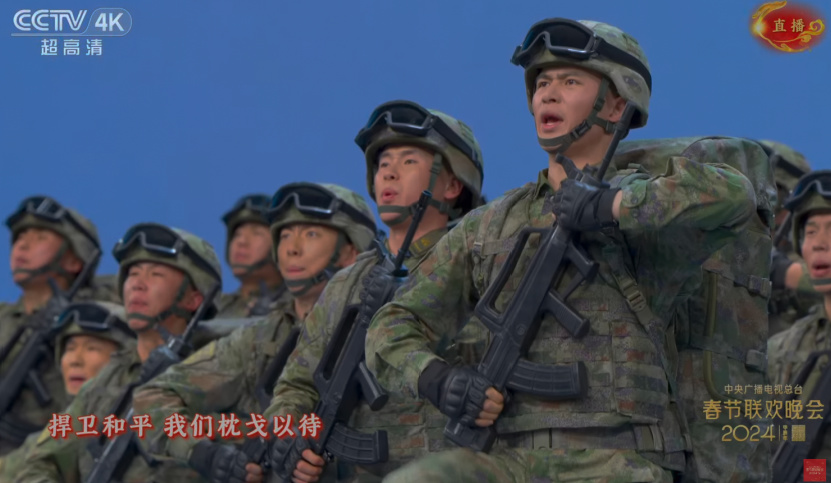
🏔️ This year’s Gala will not only feature performances from Beijing but also sub-venues in Wuhan, Lhasa, Wuxi, and Chongqing. For these cities, it’s a valuable opportunity to promote local culture and attract more tourists.
🤖 In recent years, the Gala has also become a platform to showcase China’s innovative digital technologies. In 2021, the show explicitly branded itself as a “tech innovation event” by incorporating 8K ultra-high-definition video, AI+VR studio technologies, and cloud-based performance coordination. This year, expect even more cutting-edge tech, including virtual production, 3D effects, and advanced AI, to bring Chinese cultural performances to life while underscoring China’s role as a global tech leader.
🧏♂️ Notably, this year’s Gala will feature audio-described and sign language versions for the first time, making it accessible to visually and hearing-impaired audiences. Sign language interpreters, using AR virtual technology, will appear in the Gala studio alongside the live broadcast. A split-screen feature will show both the live program and the interpreters, supported by AI-generated subtitles for hearing-impaired viewers. This marks a significant step toward a more inclusive approach by state media.
📕 One of this year’s key sponsors is Xiaohongshu (aka Rednote), an app that has recently dominated headlines as a surge of “TikTok refugees” migrated to its platform. Partnering with the Spring Festival Gala is a major traffic and visibility boost, making this one of Xiaohongshu’s most commercially successful years since its 2013 launch.
👩🏻 Also noteworthy: for the third time in a row, the Gala is directed by female director Yu Lei (于蕾), who also directed the 2024 and 2023 Gala. The 46-year-old Yu Lei previously also served as the general scriptwriter and overall designer for the Gala. The past year has really been a flourishing year for female directors in China, from cinema to TV, where female directing talent has been more visible and successful than ever before. This rise of female talent is also reflected in the Gala’s top creative team consists of 19 people: 11 of them are female.
📽 By now, the last rehearsal of the show has already been completed. The entire show is usually completely rehearsed a total of five times before Chinese New Year’s Eve. These rehearsals are recorded and almost nothing ever goes wrong during the live show – besides some bad lipsyncing here and there – since the recording is running at the same time so that producers can always switch to a pre-recorded act.
🔶️ On January 28, the show will also air via various channels, from CCTV to Bilibili, and also via Youtube here. The entire programme is usually released a day before.
Happy watching! Wishing you all joy, prosperity, plenty of dumplings, and good health in the Year of the Snake.
Best,
Manya
(@manyapan)
What’s on Weibo Chapters

Last week, I shared the first deep dive of What’s on Weibo Chapters with you. This month, our theme is 15 Years of Weibo. This week, Sinologist and China correspondent Casper Wichmann shares his insights on Weibo’s evolving role in shaping public opinion, its key moments, and whether it can remain a major platform for public discourse in China’s increasingly crowded digital landscape. At the University of Copenhagen, Wichmann previously researched Sina Weibo as a new public sphere on the Chinese internet.
With Weibo now 15 years old, we asked Wichmann about three things:
📌 Weibo’s evolving role in shaping public opinion: Has it become more or less effective, and has its social impact shifted? Which news stories highlight Weibo’s continued relevance or its changing influence?
📌 Changing government strategies on the Weibo platform: What pivotal moments stand out when Weibo emerged as a political tool?
📌 Weibo’s present & future in a crowded digital landscape: Can it still compete as a major platform for public discourse, or is it transitioning into a new role altogether?
Read this feature article to find out what Casper had to say about this:
What’s Popular

– by Ruixin Zhang
“What should we order for dinner?” is a daily dilemma for millions of Chinese consumers in one of the world’s largest food delivery markets. With numerous platforms, cuisines, menus, and discount options, choosing the right takeout—one that is tasty, affordable, and safe—can feel like a daunting task.
But these days, many Chinese people follow a simple rule to identify bad takeout: if your delivery comes in packaging featuring a playful young woman wearing sunglasses, a traditional Peking opera headdress, and holding a fan—often with the bold trendy character “潮” (cháo, meaning “trend”)—it’s likely to be an unhealthy meal with potential food safety risks.

As one netizen joked, “I was so excited for my takeout, only to see this lady on the package and feel my heart sink.” Why does this seemingly cheerful cartoon figure has come to evoke so much distrust and dislike?
This story starts in 2020, when digital illustrator @YUMI created the “China-chic Girl” image in response to a client’s request for a design that embodied the “China-chic” (国潮, guócháo) aesthetic.
China-chic, or guócháo—literally meaning “national tide”—refers to the rise of Chinese domestic (fashion) brands that often incorporate culturally Chinese elements into contemporary designs. This trend emerged as a reflection of growing nationalist sentiment in China, offering a Chinese counterpart to popular Japanese or Korean-inspired styles. From fashion and makeup to milk tea, ‘China-chic’ quickly became a defining element of China’s consumer culture (read more here).
However, when YUMI’s client failed to pay, she chose to release the design for free public use. YUMI’s creation—a blend of traditional Peking opera elements and modern sunglasses—struck a chord with its simple yet iconic charm. Its accessibility made it even more appealing, and the China-chic Girl soon became the go-to design for restaurants looking for affordable, visually striking takeout packaging.
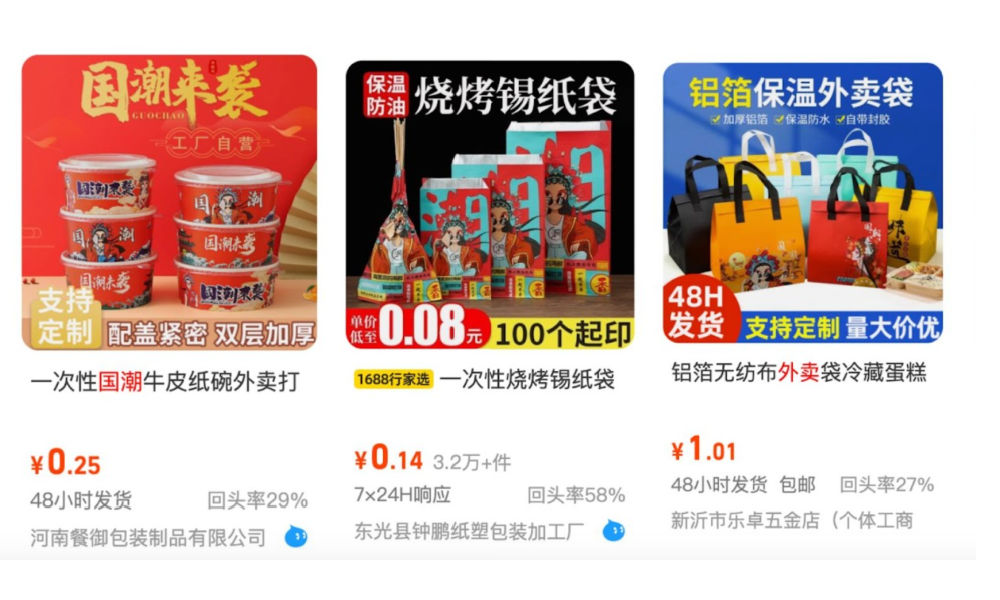
On China’s wholesale website 1688, you can find a wide range of cheap takeout packaging with the “China-chic girl” on it.
The China-chic Girl was all the rage, until last fall.
Starting in September, some delivery drivers began exposing filthy kitchen conditions on social media, warning customers to avoid takeout from certain restaurants after witnessing food safety issues and kitchen hazards while waiting for orders.
Over time, people began noticing a pattern: the dirtiest kitchens were often small, non-chain establishments with no physical storefronts—just cramped spaces dedicated solely to takeout. Operating on tight budgets, these businesses often chose the inexpensive China-chic girl packaging to cut costs, unintentionally associating the China-chic girl with unsanitary and unsafe food practices.
As a result, netizens—especially young people who heavily rely on food delivery—started compiling guides to help each other avoid sketchy takeout options. The warning signs? Restaurants offering “cashback for good reviews” or those that lack a proper storefront, often listing only food items instead of a real restaurant name. These red flags point to private kitchens, poorly managed spaces, or even unregulated food safety practices. Additionally, many of these ‘China-chic takeouts’ thrive within the “group-buying” model on food delivery platforms.
The “group-buying” model, popularized by platforms like Temu and its Chinese counterpart Pinduoduo (拼多多), allows users to invite friends, family, or colleagues to purchase a product together at a discounted price.
This strategy has since evolved into a pseudo-group-buying model, where even without inviting others, the group-buying discount is still applied. These discounts are carefully calculated by platforms to ensure that, even at reduced prices, profits can still be made due to the high sales volume.
Both Meituan (美团) and Eleme (饿了么)—the two largest food delivery platforms in China—have adopted this approach by introducing budget-friendly services such as Pinhaofan (拼好饭) and Pintuan (拼团) to target lower-tier markets.
For example, a typical 30 RMB ($4.15) takeout might cost only half that price through these services, with additional platform coupons and new user discounts making it almost irresistibly affordable.
But, of course, there’s no such thing as a free lunch. As many users have discovered, getting a full meal for under 10 RMB ($1.40) often comes at the expense of quality. These Pinhaofan takeouts commonly feature pre-made dishes with indistinguishable ingredients, flimsy utensils that can’t even scoop rice, a box of suspicious juice full of artificial coloring, low-grade packaging, and, of course, that cheap, once-iconic China-chic design.
(Want to know more? There’s more to know on how “China chic girl” has gone from being a playful symbol of pride in domestic products to representing the problems of China’s fast and cheap takeout industry: read the rest of the article here.)
What’s Noteworthy

Since the week was filled with headlines about Trump’s inauguration, you might have missed another major event: the breakthrough of China’s “Artificial Sun,” a nuclear fusion reactor, which broke its own record and brought humanity closer to achieving near-limitless clean energy. Online, this milestone was celebrated as a sign of China’s growing technological and scientific leadership, with many envisioning a future of carbon-free energy led by China.
The record was set on January 20, when the Chinese Experimental Advanced Superconducting Tokamak (先进实验超导托卡马克实验装置), or EAST, operated stably for 1,066 seconds. EAST is a nuclear fusion reactor located at the Hefei Institute of Physical Science in Anhui province, designed to generate clean and sustainable nuclear energy.
EAST is often called the “Artificial Sun” because it mimics the process that powers stars—fusing hydrogen atoms to release vast amounts of energy in the form of heat. During this experiment, EAST generated temperatures exceeding 100 million degrees Celsius—around seven times hotter than the Sun’s core. This new record surpassed the previous one of 403 seconds, also set by EAST in 2023, by more than double.
This “triumph” sparked widespread excitement on platforms like Weibo. Hashtags such as “Artificial Sun Sets 1 Billion Degrees for 1,000 Seconds” (#人造太阳创1亿摄氏度1000秒纪录# ) and “China’s Artificial Sun Makes Major Breakthrough” (#中国的人造太阳有重大突破#) made it into the top trending lists. Notably, some netizens framed the achievement within the context of global technology competition, proudly highlighting China’s progress as surpassing that of the US and EU.
What’s Memorable

As the 2017 Chinese New Year approached, a humorous and unique song went viral on Chinese social media. It captured the pressure young people face when bombarded with nagging questions from family and relatives during the Spring Festival.
Composer Jin Chengzhi (金承志) and his choir, The Rainbow Chamber Singers (上海彩虹合唱团), won the hearts of Chinese netizens with their hit song “What I Do Is For Your Own Good” (春节自救指南, literally: The Spring Festival Survival Toolkit). A perfect pick for this week’s archive spotlight—check out the explanation and video via the link below.
Weibo Word of the Week

Fake Foreigners | Our Weibo phrase of the week is 仿冒外国用户账号, fǎngmào wàiguó yònghù zhànghào, meaning “fake foreign user accounts” or “user accounts that pretend to be foreigners.”
The phrase came up in a Weibo hashtag last week that attracted over 210 million views (#抖音已处理1万多仿冒外国用户账号#), about Douyin, the Chinese version of TikTok, having dealt with more than 10,000 fake foreign accounts in the wake of the “TikTok Refugee” trend.
In case you missed it (though you probably didn’t): With a TikTok ban looming in the US (briefly taking effect last Sunday before being delayed), millions of American TikTok users began migrating to other platforms this month. The most notable was the Chinese social media app Xiaohongshu (also known as Rednote), which saw a huge influx of so-called “TikTok refugees” (TikTok难民). Many were searching for what they believed to be a “Chinese version of TikTok” (read more about the story here). Seeing Xiaohongshu’s success, Douyin, the actual Chinese version of TikTok, also opened its registration process to international users.
What started as a protest against the TikTok ban and US policies turned into a surprising celebration of cultural exchange. Chinese and American netizens found a digital space to interact and connect—on the Chinese internet.
However, the hype also brought its downsides. Black market groups quickly jumped on the trend, looking to profit by gaining followers and click traffic. They created thousands of fake “foreign” accounts by reposting videos or even crafting AI-generated foreign personas.

Is the painting moving, or is this just another fake foreigner?
This phenomenon has fueled skepticism among Chinese internet users—already wary of online scams—about connecting with strangers online. One netizen joked, “Don’t buy anything from people and don’t make new friends, and you’ll never be scammed.”
Others commented: “Xiaohongshu and Douyin’s teams must be swamped these days. Meanwhile, Weibo is nice and quiet in comparison!”
This is an on-site version of the Weibo Watch newsletter by What’s on Weibo. Missed last week’s newsletter? Find it here. If you are already subscribed to What’s on Weibo but are not yet receiving this newsletter in your inbox, please contact us directly to let us know.
Popular Reads
-
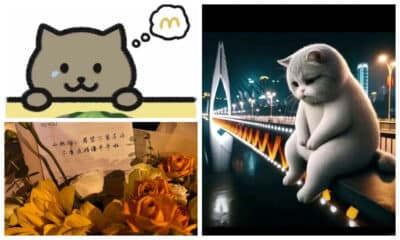
 China Insight10 months ago
China Insight10 months agoThe Tragic Story of “Fat Cat”: How a Chinese Gamer’s Suicide Went Viral
-

 China Music11 months ago
China Music11 months agoThe Chinese Viral TikTok Song Explained (No, It’s Not About Samsung)
-
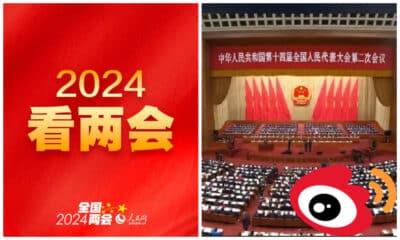
 China Insight12 months ago
China Insight12 months agoThe ‘Two Sessions’ Suggestions: Six Proposals Raising Online Discussions
-

 China Digital9 months ago
China Digital9 months agoChina’s 2024 Gaokao Triggers Online Discussions on AI






